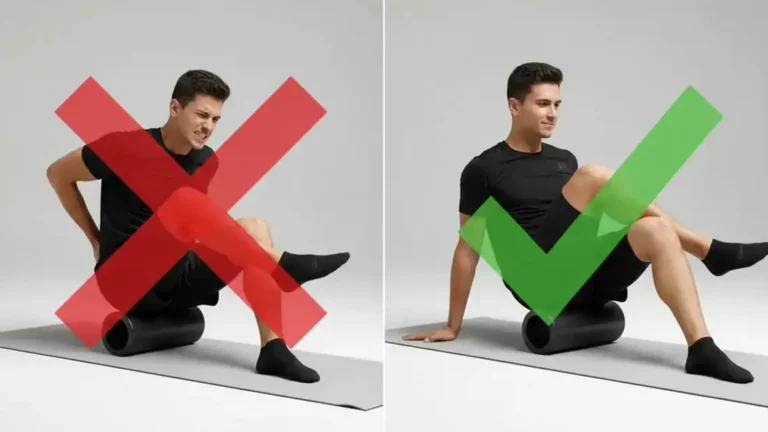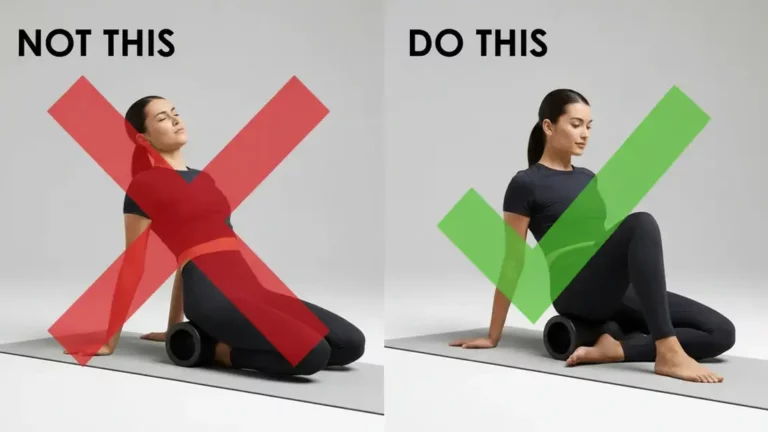Are you struggling to complete your bodyweight workouts?
Believe it or not, breathing for bodyweight exercises is a surprisingly powerful technique to help you take your performance to the next level and is often a game changer for overall fitness.
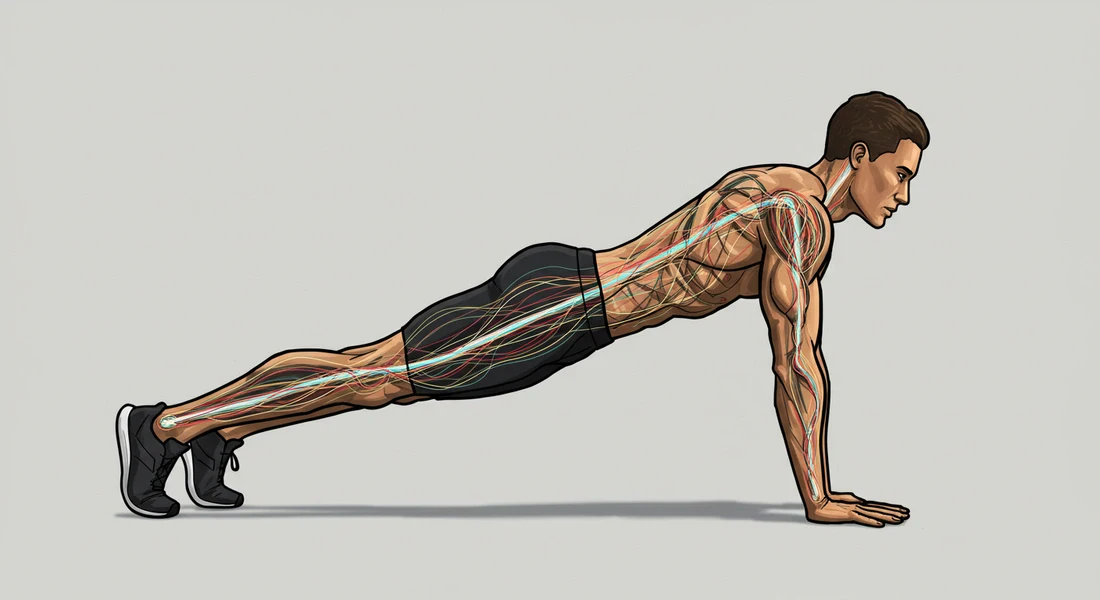
The way you breathe can play a key role in your strength, your focus, and your stamina during even the most challenging exercises.
This article will help you to unlock the secret weapon that will help you to breathe better and also power through your workouts!”
The Key Benefits of Bodyweight Exercises
Bodyweight exercises harness your own body weight to build strength and endurance.
These require no equipment, and they can be done anytime, anywhere.
Bodyweight training provides a versatile and effective way to improve overall fitness, by working all of the major muscle groups of the body.
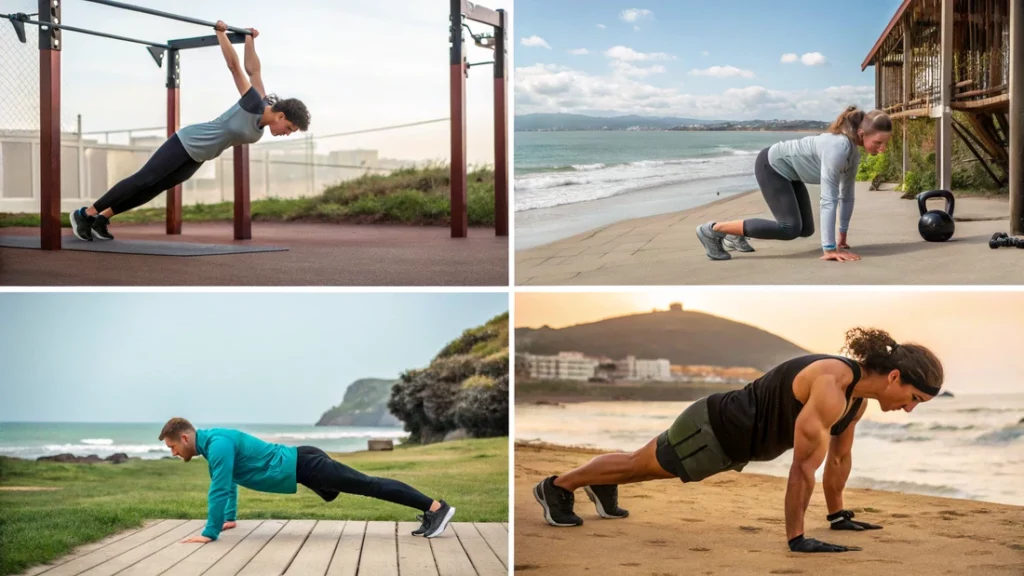
Key Benefits
- Versatile and Accessible: Bodyweight exercises can be performed anywhere, without requiring specialized equipment or a gym membership, which makes them perfect for training in any environment.
- Full-Body Workout: Most bodyweight movements are compound exercises, engaging multiple muscle groups simultaneously, including your core, legs, arms, and back. This provides a full body workout in every session.
- Effective for All Levels: Whether you are a beginner, or a seasoned athlete, bodyweight exercises are a great option for anyone who wants to improve their strength and fitness. They are a building block for any fitness program.
How Proper Breathing Fuels Your Bodyweight Workouts
Now that you have a solid understanding of bodyweight exercises, let’s explore why breathing is so vital for maximizing their effectiveness.
The ability to implement correct breathing methods, makes or breaks any fitness routine, and is often overlooked.
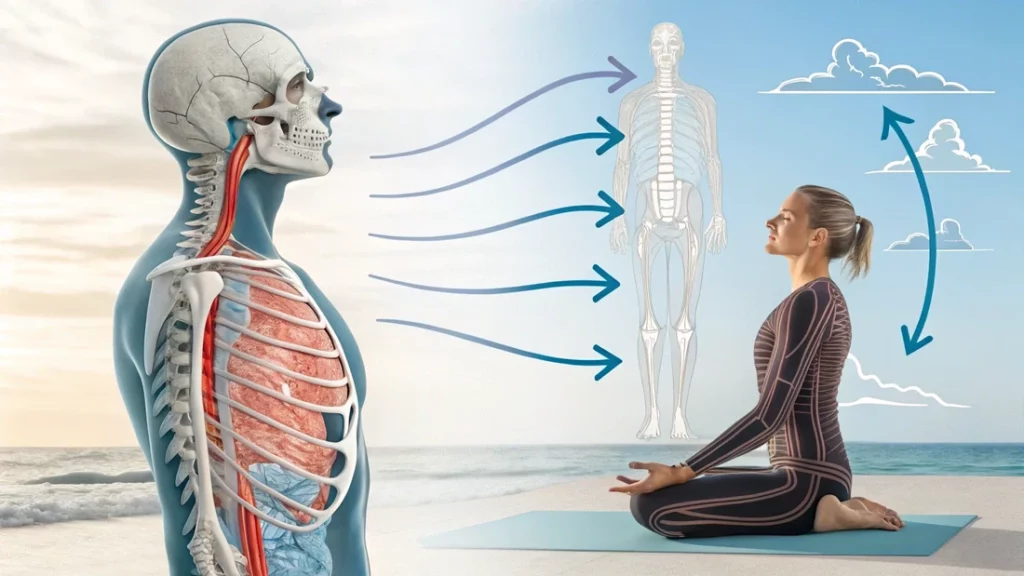
Key Concepts
- Breathing and the Musculoskeletal System:
- Proper breathing engages your diaphragm, which supports the core muscles that connect to your spine. This creates a more stable base during bodyweight exercises, allowing for improved muscle activation and reducing the risk of injury. Core stability exercise principles have also been shown to play a key role in injury prevention [Core Stability Exercise Principles]. By practicing mindful breathing, you can also improve the connection to your body, which will assist in having more control during your workouts.
- Breathing and Force Production:
- The ability to breathe correctly has a massive impact on how much power your body can generate. Forceful exhalations during exertion, will allow you to generate more power, and it can also have a huge impact on the amount you can lift during your workout.
- Breathing and Intra-Abdominal Pressure:
- The method of breathing you use helps to regulate intra-abdominal pressure, which is the pressure inside your abdominal cavity. Maintaining the correct pressure is very important for preventing injuries and will also provide support for your spine.
- By using the correct breathing methods, you will be setting yourself up for more effective and safe workouts.
- Common Misconceptions:
- Misconception: You don’t need to focus on breathing during workouts, as it happens automatically.
- Reality: Although breathing is an autonomic function, actively focusing on it can improve your strength and endurance.
- Misconception: Breathing exercises are only for relaxation.
- Reality: While breathing exercises are used for relaxation, specific techniques can also enhance muscle function and power output.
The Best Breathing Techniques to Power Through Bodyweight Exercises
Let’s now explore some of the best breathing techniques to use in conjunction with some common bodyweight exercises, and I’ll share some advice to help you master these breathing patterns to help with your performance.
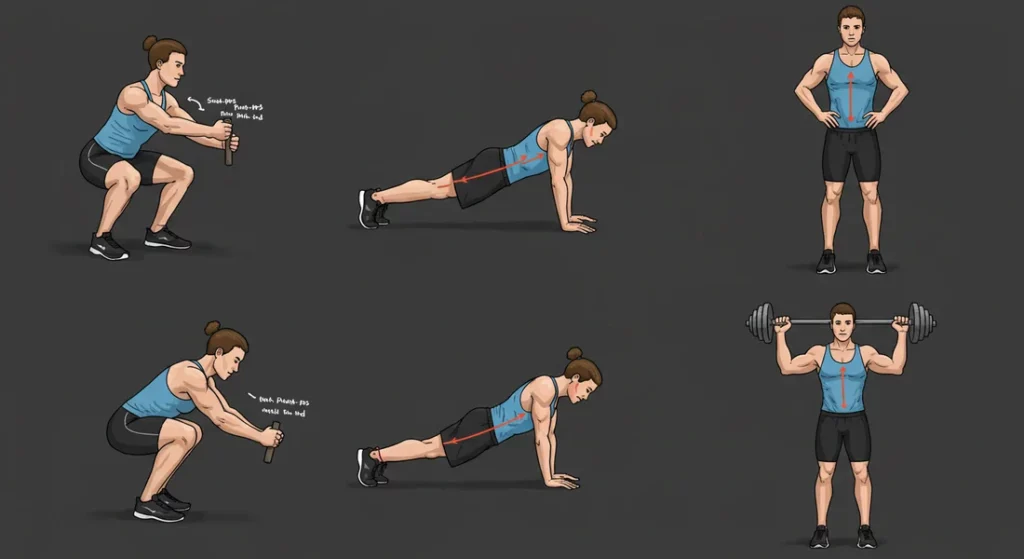
Techniques and Tips
- Push-Ups:
- As you lower your body towards the floor, inhale deeply through your nose to fill your lungs with air.
- As you push your body back up, exhale forcefully through your mouth, while engaging your core. Make sure to tighten your abdominal muscles for core support, as you push upwards.
- Squats:
- Before you lower into the squat, take a deep breath to engage your abdominal muscles and set your core.
- Hold your breath as you lower down, then forcefully exhale as you push back up to the starting position, while also engaging your core muscles.
- Planks:
- During a plank, try to focus on engaging your diaphragm and to avoid holding your breath.
- Take controlled, deliberate breaths, and focus on feeling your stomach pressing against the floor. This is a test of your mental strength, and you should also focus on mindfulness.
- Pull-Ups:
- As you hang down, take a deep breath and prepare to engage your core muscles.
- As you pull yourself up, make a controlled exhale, and brace your core for a successful pull-up.
- At the top, and as you are coming down, take an active and controlled inhale.
Table – Summary of Exercises
It can be difficult to retain all of these techniques, and to help you to remember them, here is a clear and simple table.
| Exercise | Inhale | Exhale | Core Engagement |
| Push-Ups | As you lower your body towards the floor | As you push back up | As you push your body up |
| Squats | As you engage your core at the top | As you explode back to a standing position | As you start your descent and ascent |
| Planks | Take controlled, deliberate breaths | There is no exhalation | As you hold the plank |
| Pull-Ups | As you hang down before you begin | As you pull yourself up | As you perform the movement |
Troubleshooting Breathing Challenges During Workouts
Like any skill, learning to breathe effectively during bodyweight exercises can come with its own set of challenges.
It is important to not get disheartened, and instead, to view any challenges as new learning opportunities.
Here are some practical tips on how to address and overcome them, and what to do if you are struggling.
Key Challenges & Solutions
- What to do if you feel lightheaded?:
- If you experience dizziness or lightheadedness during or after your exercises, it may be due to hyperventilating, or breathing too rapidly. This can lead to a change in carbon dioxide and oxygen, which may leave you feeling lightheaded. If you experience this, immediately stop what you are doing, and focus on slowing down your breath. You should also try to take several breaths in a seated position, until you feel well enough to continue.
- What if you can’t coordinate breath with movement?:
- Coordinating your breath with movement can be one of the most difficult aspects of taking control of your breathing. At first, it can be very difficult to keep this going, and it may feel unnatural. If you are struggling with this, try to focus on slowing down your workout routine. By reducing the amount you are doing, this will allow you to focus more on your breathing patterns and allow your body to better adapt to this new skill. With consistent practice, you will find it much easier!
- What if you have existing respiratory conditions?:
- If you have asthma or another lung condition, it is vitally important to seek medical advice before trying any new breathing exercises. You must understand how your body is going to react and also any potential dangers to performing certain methods of breathing. Your doctor can provide personalized guidance and recommendations that will help you to enhance your breathing and also prevent any negative side effects.
Practical Tips To Enhance Your Breathing During Bodyweight Exercises
To make breathing a seamless and powerful aspect of your bodyweight workouts, here are some practical tips to integrate into your routine.
These tips will help you to get the most out of your breathing, and they will also help to ensure your body is performing at its best.
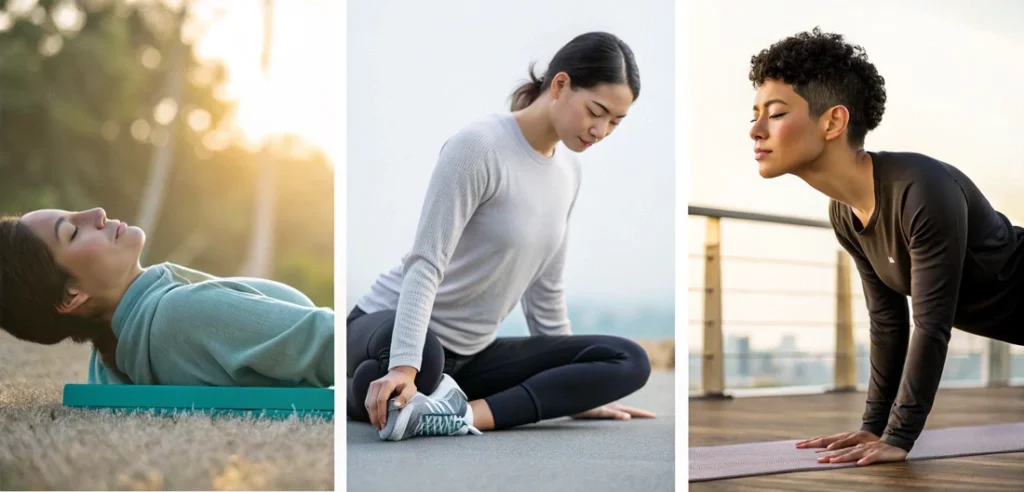
Key Tips
- Focus on the Exhale:
- During the most challenging portion of a bodyweight exercise, such as pushing up during a push-up or pulling yourself up during a pull-up, focus on a strong and deliberate exhale. This helps to stabilize your core, engage the correct muscles, and to generate more power.
- Visualizing and engaging in a forceful exhale, will also help you to connect to your breath, and be more mindful of the process. Make sure you focus on controlling the exhale, and letting it all out.
- Engage Your Core:
- With every breath, be conscious of engaging your core muscles, particularly your transverse abdominis. This supports your spine, enhances stability, and facilitates more efficient breathing.
- By engaging your core muscles, you will also activate the other correct muscles in your body, and help to protect yourself from injury. To practice this, focus on pulling your belly button towards your spine.
- Use Verbal Cues:
- Sometimes, when you are pushing yourself, it can be hard to remember to breathe, which is why it can be helpful to use verbal cues. Silently saying “inhale” and “exhale” during the different parts of the movement can help you to stay on track and will also assist in performing the movements correctly.
- Using verbal cues can also be used to create focus and also promote mindfulness of your breath.
- Be Patient:
- Mastering proper breathing takes time and patience, and you should not expect to be perfect right away. Focus on consistency and be mindful of the progress that you are making. Remember that even making small improvements, can add up to significant changes over time.
- Try not to rush the process. You can see improvements overtime with a mindful and consistent practice, and this will ensure that you are making a real change, rather than just a temporary fix.
Frequently Asked Questions About Breathing and Bodyweight Exercises
To provide you with all the information you need to master breathing and bodyweight exercises, here are some of the most frequently asked questions on this topic.
These answers are carefully crafted to give you the most actionable advice possible!
- Question 1: Why is it so important to breathe during bodyweight exercises?
- Answer: Breathing during bodyweight exercises is vital as it plays a key role in maintaining energy levels, supporting core stability, and enhancing force production. Correct breathing methods will also help to ensure that your body can perform the exercises correctly, and reduce your chances of injury.
- Question 2: “What is the best method for breathing during pull-ups?
- Answer: For pull-ups, focus on taking a deep breath as you are hanging down, and then engage your core and exhale as you pull yourself up. Then inhale as you are coming down.
- By coordinating this, you will create a strong movement that focuses on both breathing and proper technique. It can take some time to master this method, so remember to be consistent and also be patient.
- Question 3: How does controlled breathing help improve posture?
- Answer: Controlled breathing, especially belly breathing, can improve posture by engaging the deep core muscles that support your spine. Focusing on proper form throughout all movements will also help to give you the best possible foundation for success.
- Question 4: Is there a particular breathing pattern that’s ideal for push-ups?
- Answer: When you are performing push-ups, you should aim to use consistent breathing by inhaling as you lower yourself down to the floor, and then exhaling as you come back up. Make sure that you are engaging your core throughout the exercise.
Final Thoughts on Breathing and Bodyweight Exercises
As we reach the end of this guide on breathing and bodyweight exercises, it is hoped that you are now feeling equipped to enhance your overall performance and fitness journey.
Here’s a recap of some of the key points that will help you achieve this.
Key Takeaways
- Breathing is a Valuable Tool: Breathing is an essential element for all bodyweight exercises.
- Master the Main Methods: Try to master the belly breathing, paced breathing and breath awareness, to help improve the quality of your workouts.
- Core Engagement: Don’t forget to engage your core and to connect with your body.
- Consistency: Ensure to take it slow and to build a consistent routine, as this is the key to improving your health and fitness.
- Practical Application: Make a commitment to implementing these into your daily routine, and always listen to your body.
Now, I encourage you to take these tips and start to improve your fitness journey.
By implementing mindful breathing, you will be amazed at the difference it makes.
So go ahead and start to take advantage of the transformative power of breath!
Reference
Core Stability Exercise Principles [https://pubmed.ncbi.nlm.nih.gov/18296944/]

